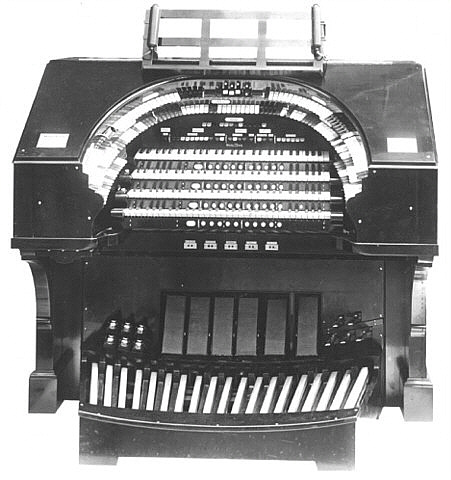
The Second-Largest Wurlitzer
Ian R McIver

Photo from Al Sefl collection
We all know that the largest organ built by Wurlitzer (excluding the one assembled at De Kalb in the 1970s) is the one still at Radio City Music Hall, where it was installed in 1932.
Many would be hard-pressed to identify correctly the second-largest, the subject of this article:
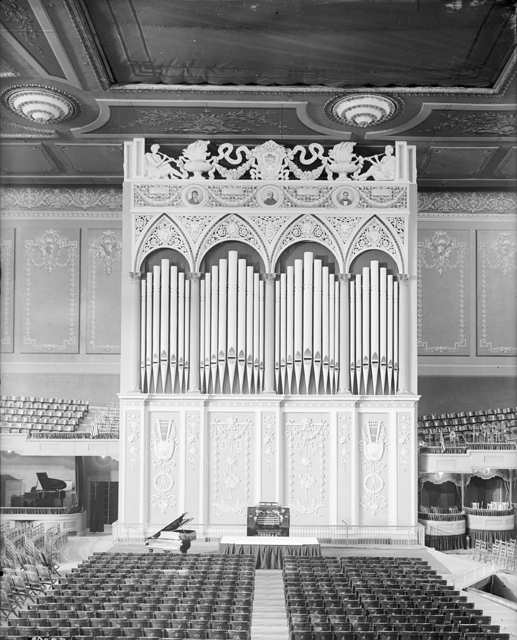
Denver Municipal Auditorium
Denver featured significantly in the early history of the Wurlitzer company, as it was the location of two of the largest pioneer instruments. A 3/13 Style 6 instrument installed in the Paris Theatre in 1913, followed by the 4/28 in the Isis Theatre in 1915. At the time the instrument in the Isis was the largest organ Wurlitzer had built, but it was surpassed in 1917 by the 4/32 at the California Theatre, San Francisco.
Hope-Jones died in September, 1914, but he had already interested the Denver authorities in purchasing a Wurlitzer organ for their Municipal Auditorium. One of the stipulations of the payment by two railway companies to the City of Denver of $50,000 for the rights to lay tracks down Market Street was that the money be used to finance an organ for the municipal auditorium. A contract was placed by Mayor Speer with the Skinner Company in May, 1912 for a $42,000 organ. This was cancelled when a new mayor, opposed to the organ, was elected.
Meanwhile Hope-Jones was in Denver arranging the installation of the 3/13 in the Paris Theatre, and persuaded the Mayor Speer that what the city needed was a Wurlitzer Hope-Jones organ. No progress was made until Mayor Speer was re-elected in 1916, when he revived the organ project and placed the contract with Wurlitzer. Thus it was not until 1918 that Opus 154 was built and erected in the Auditorium.
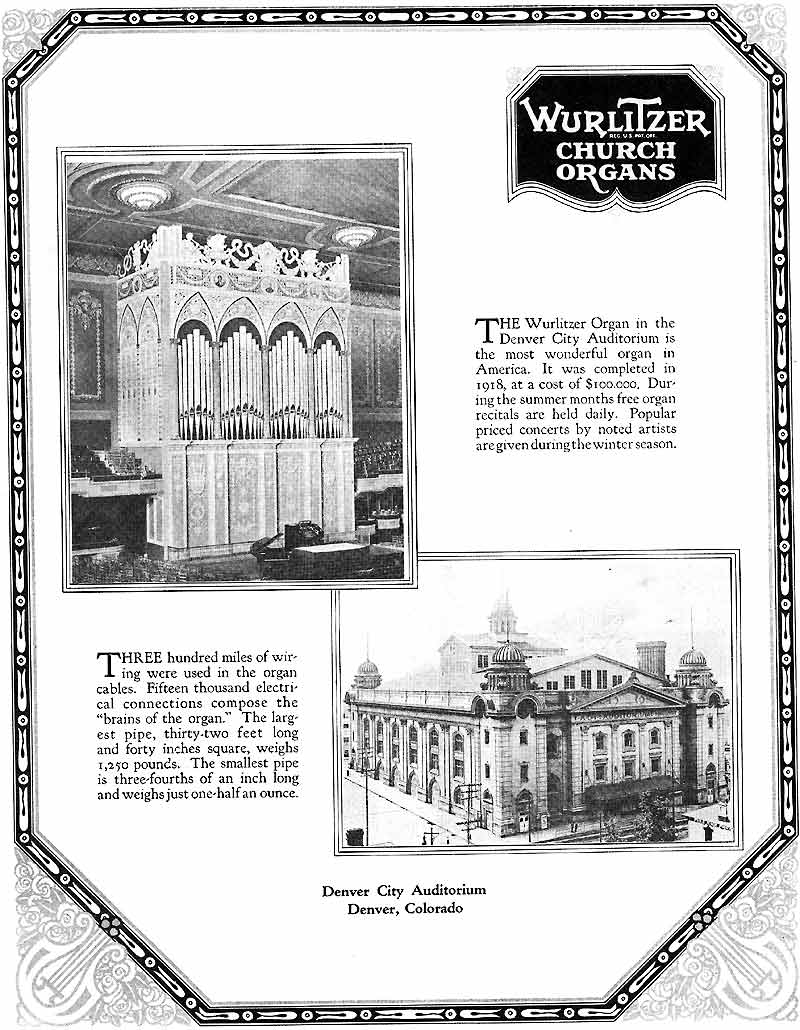
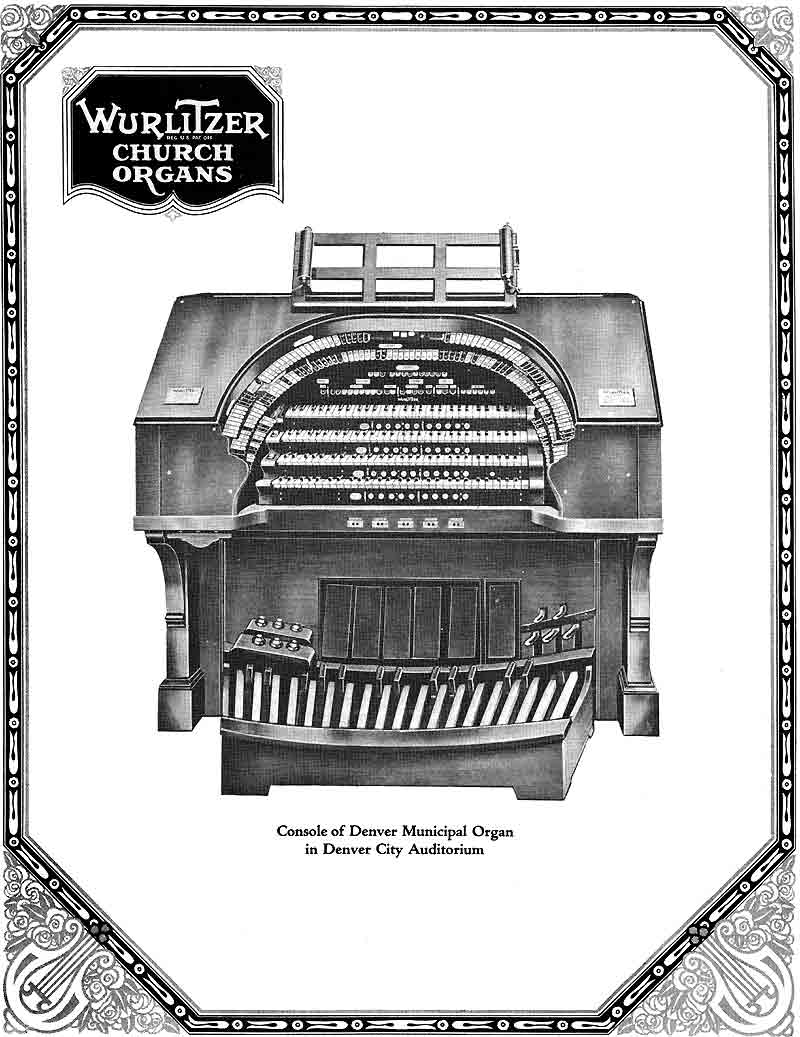
The City of Denver was rightly proud of its new instrument - a set of photographs taken during the installation process is still held in the Colorado State Archives. Some of these illustrate this article.
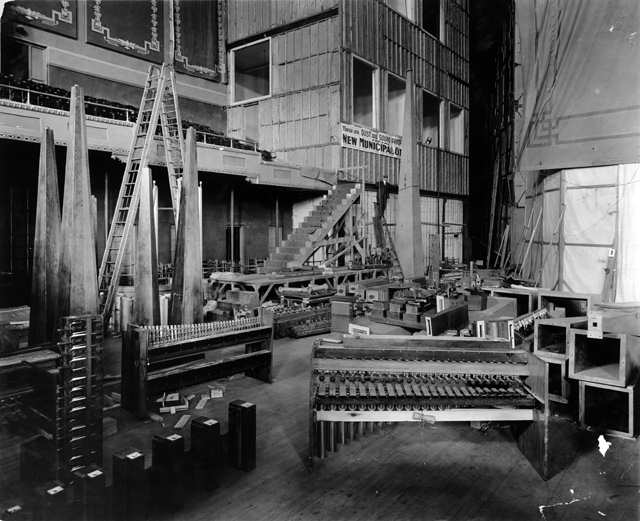
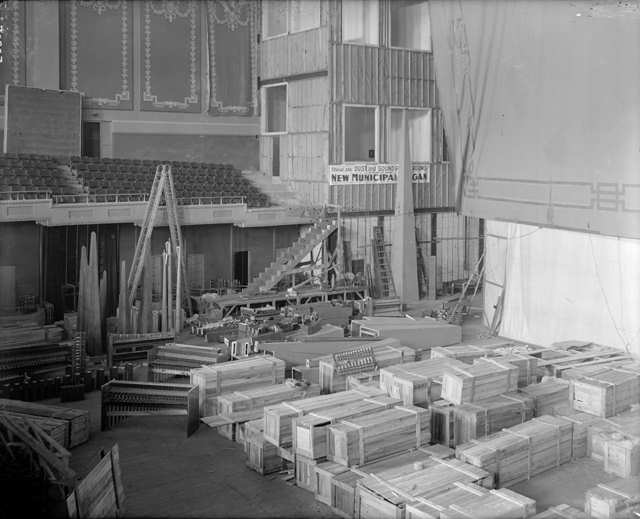
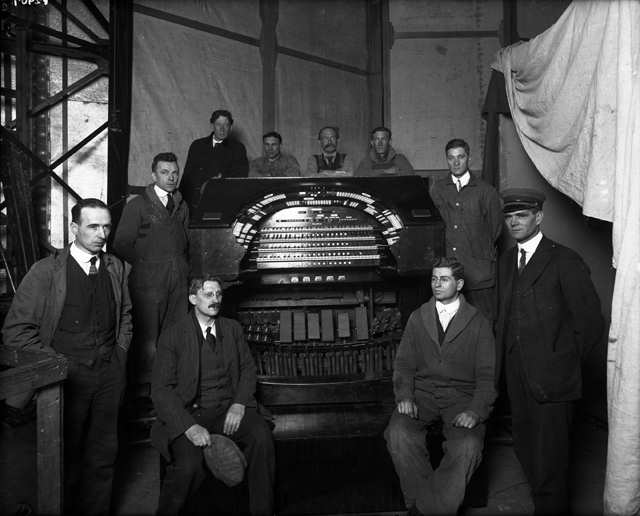
The assembly crew, with Organ Custodian G Foote in uniform at right
Not only was the Denver municipal organ the largest Wurlitzer to be built until 1932, it contained many unusual features that point to it being designed by Hope-Jones, who probably prepared detailed plans for the instrument in 1912-13. In 1912 he had been referring in correspondence with Farney Wurlitzer to a projected cost of $65,000 for the instrument, plus $10,000 for construction of the chambers in the hall. According to the “Wurlitzer Church Organs” catalogue of 1924, the final cost of the organ was $100,000.
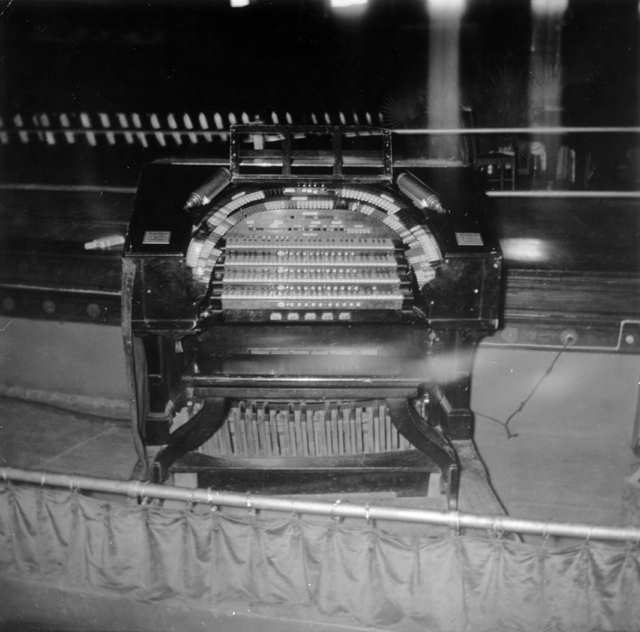
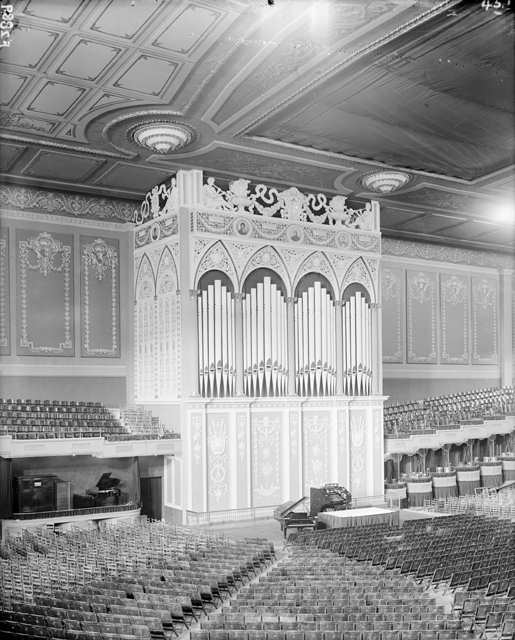
Note the roll-player console at extreme left
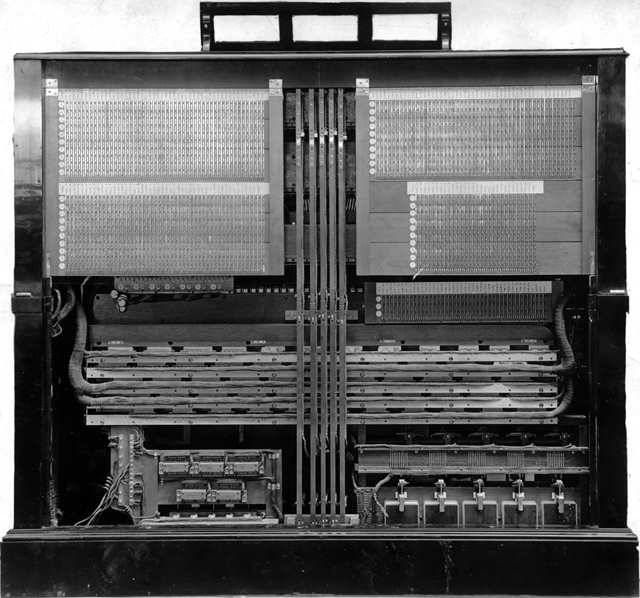
Inside the back of the console
The organ comprised 34 units (some sources quote 35 units, regarding the two-rank solo string as two units), with 40 actual pipe ranks. Two of the units were available only on the pedal organ, and two units contained progressively more ranks of pipes in the upper registers. As far as I am aware, this latter arrangement was unique amongst Wurlitzer organs.
.jpg)
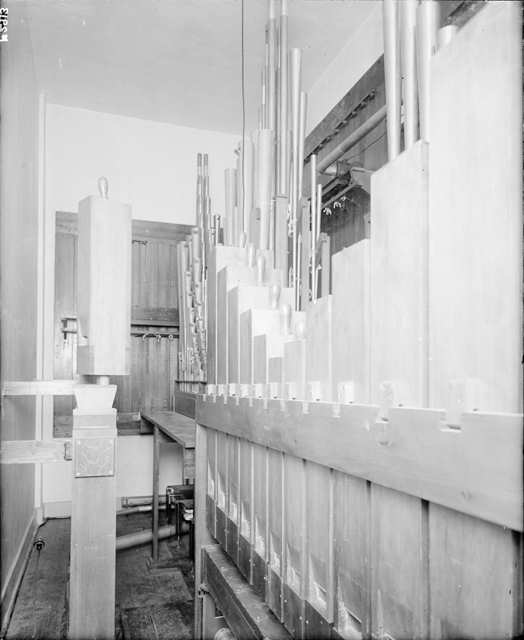
Offsets at centre left are Doppel Flutes - they have mouths on both front and back
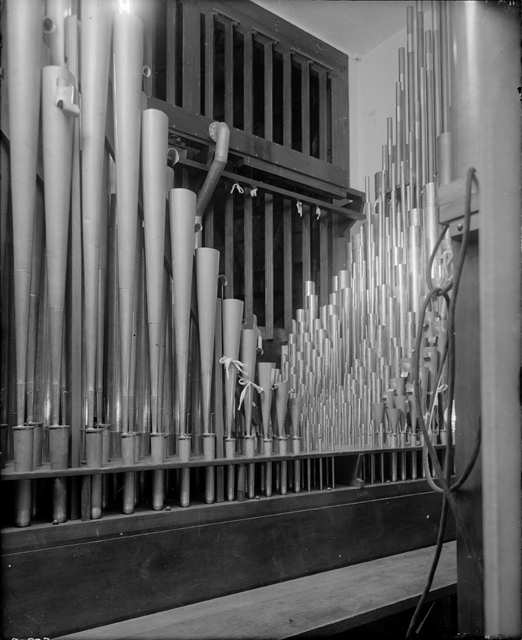
The list of ranks is as follows (each with its lowest pitch shown):
Diaphone
32
Tuba Mirabilis 32
Tuba Horn 16
Trumpet
16
English Horn 16
Open Diapason 16
Phonon Diapason 16
Tibia Plena 8
Tibia Clausa
16
Gamba 16
Gamba Céleste 8
Clarinet 16
Viol d'Orchestre 8 (2-4 rks)
Viol
Céleste 8 (1-3 rks)
Solo String 8 (2
rks)
Kinura 8
Orchestral Oboe 8
Harmonic
Flute 4
Oboe Horn 16
Doppel Flute 8
Quintadena
16
Quintadena Céleste 8
Dolce Diapason
8
Unda Maris 8TC
Echo chamber (remote - in the roof)
Bourdon
16
Horn Diapason 8
Viol d'Orchestre 8
Viol
Céleste 8
Oboe Horn 8
Flute 4
Vox
Humana 16
Vox Humana 8
Vox Humana Céleste
8
Vox Humana 4
The percussions comprised: grand piano (unenclosed), chrysoglott, Cathedral Chimes, marimba, harp (believed to be two separate instruments), glockenspiel, master xylophone, xylophone sleigh bells, and a second set of chimes in the echo chamber. There was a separate chamber for the percussions and effects.
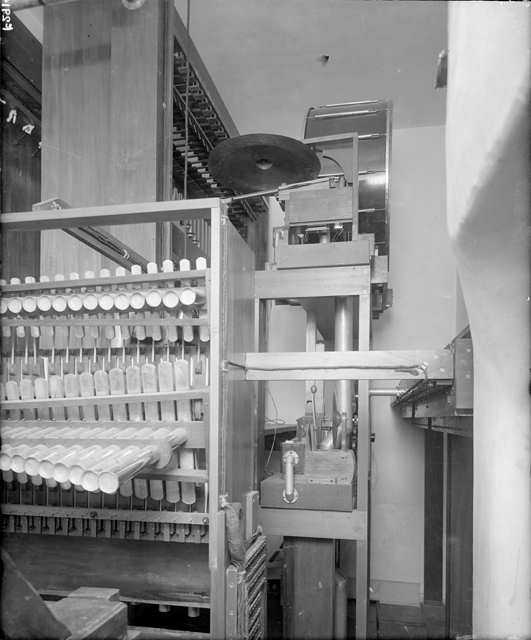
There was also the largest roll-playing unit I have ever seen attached to a Wurlitzer organ:
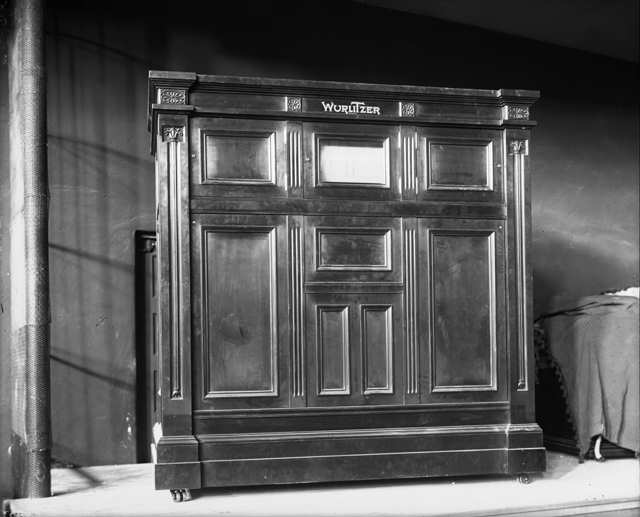
.jpg)
Inside the back of the roll-player
The Viol d'Orchestre contained very narrow-scale pipes that would not on their own have sufficient carrying power in the large auditorium. It therefore comprised two ranks of pipes at CC for the 8ft octave, three ranks for the octave from Tenor C, and four ranks from Middle C up. The accompanying VdO Céleste had a single rank of pipes for the 8ft octave, two from tenor C, and three from Middle C up.
The 32ft Diaphone unit, which at 40 inches square at the top, was probably the largest ever constructed, was available at 32ft and 16ft (with a 64ft resultant) on the pedal organ only. The full compass appears to have comprised wood diaphone pipes. The other rank exclusive to the pedal clavier was the Echo chamber Bourdon, at 16ft and 8ft.
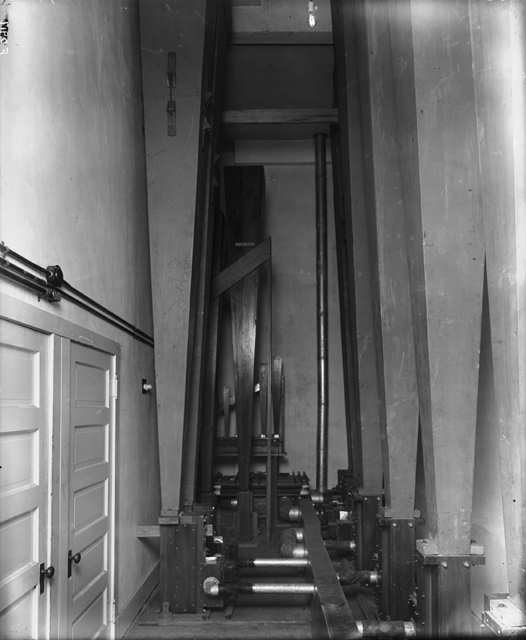
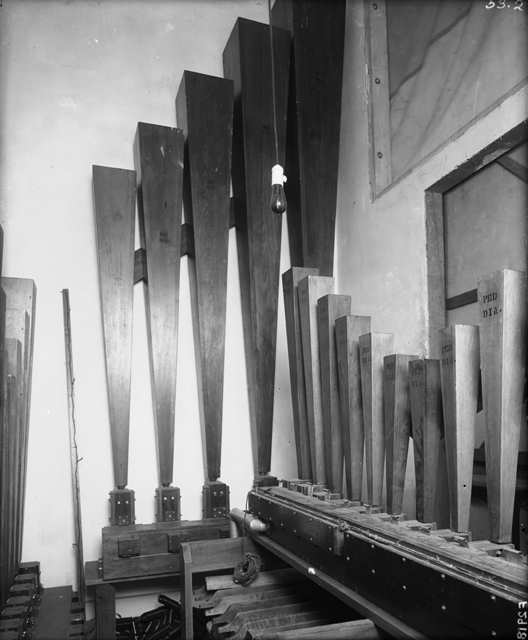
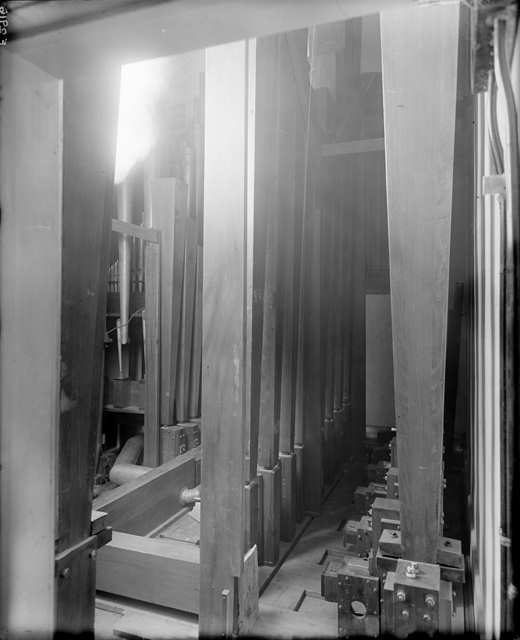
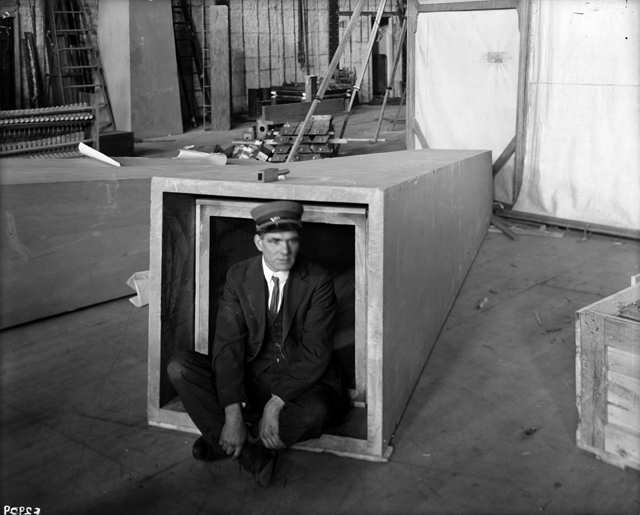
The municipal Organ Curator - Mr G Foote - tries out a diaphone pipe for size
The four-rank Vox Humana chorus was found only in three Wurlitzer organs. This was the first, the other two being the Coliseum, Seattle (Op.164) and the Liberty, Portland (Op 170). There was no other Vox Humana on the organ, and one of the 8ft ranks was soon moved to the Kinura chest in the main organ. The Kinura pipes were stored in a barrel for most of the instrument's existence. These pipes still survive. The Vox ranks stood side-by-side behind the shutters in the echo organ chamber. They are now in the organ at San Sylmar, where I saw the 16ft pipe back in 1973. This is the only part of the Denver organ I can claim to have personally seen. Strangely, that same day I had been playing one of the other 4-rank Vox sets, then incorporated into Richard Simonton's organ at Toluca Lake.
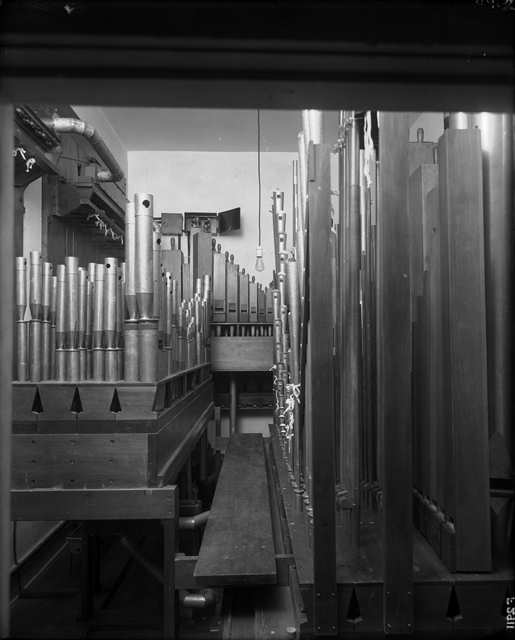
Note the four-rank Vox Humana chorus at left in this view inside the Echo chamber
Other unusual features of the organ were the 32ft reed (Bombarde) extension of 30-inch scale and on 30” wind of the Tuba Mirabilis and the 16ft extensions of the Oboe Horn, Clarinet and Quintadena. The 16ft English Horn was available only on the Orchestral manual, not on the pedals. The Doppel Flute (stopped wood pipes with mouths on both front and back), Phonon Diapason, Quintadena Céleste and Dolce Diapason were all very rare or unique ranks. It has been suggested that there were two 32ft diaphone stops on the organ, as well as the Bombarde, but no concrete evidence of the second diaphone exists – there was no provision for it on the relay. The only other Wurlitzer organ to have a 32ft reed was that at Radio City Music Hall.
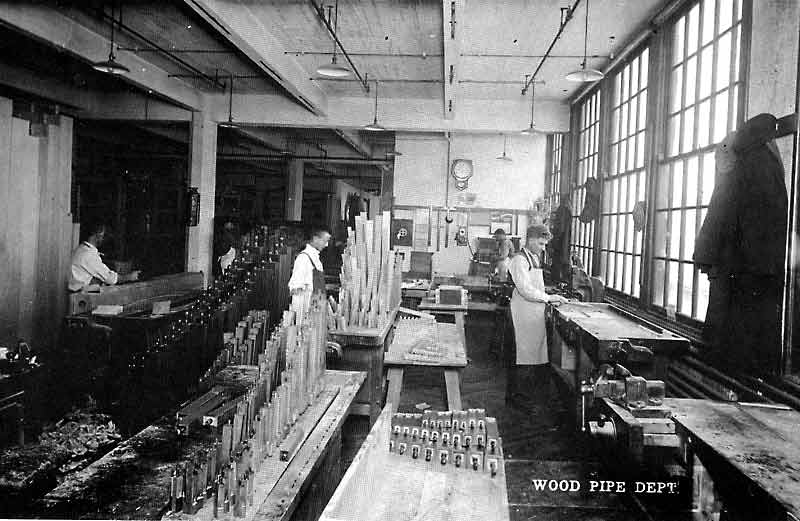
Doppel Flute pipes for Denver being made at the Wurlitzer factory
Also unusual was the omission of ranks one might expect to find. For example, there is no Concert Flute, so the Flute Twelfth and Tierce were taken from the Harmonic Flute. There is no Saxophone, Krumet, French Horn or brass rank (the trumpet was not a brass one). There was only one Tibia Clausa and a Tibia Plena.
There was a full complement of traps and effects, including, I understand, a Lion’s Roar and an Ore Dump, that involved a genuine ore car with a load of stone in a wire mesh basket that could be “dumped” on command.
Below the accompaniment manual was a set of ventil switches to cut off wind from specific chests: Diaphone, Diaphone, Tuba Mirabilis, Solo, Tuba Horn. In the event of ciphers in these prominent ranks, the ranks could be silenced until the cipher was cleared.
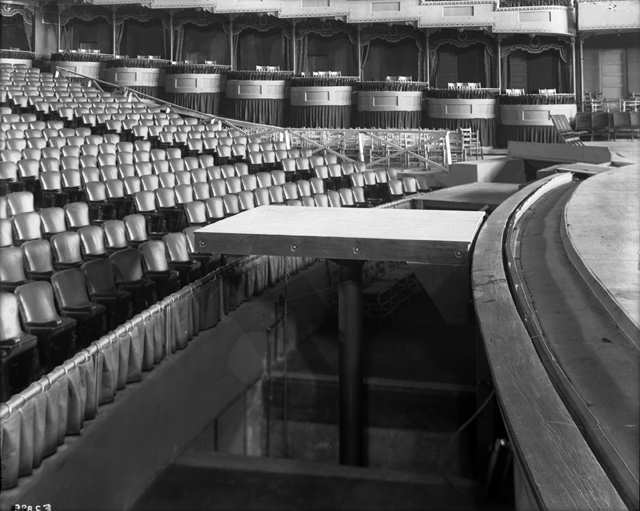
Console lift platform
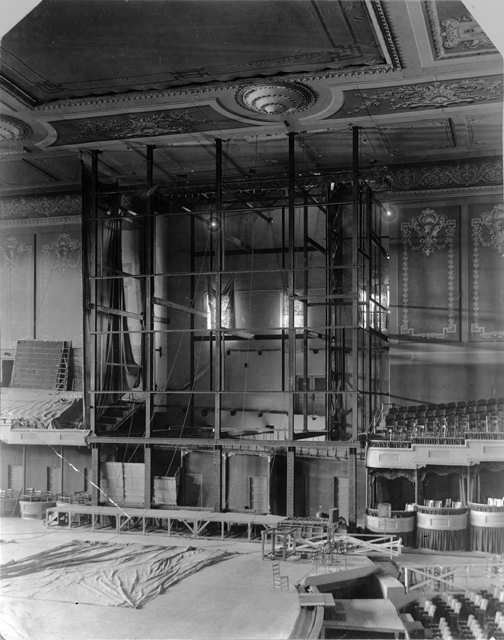
Chamber framework
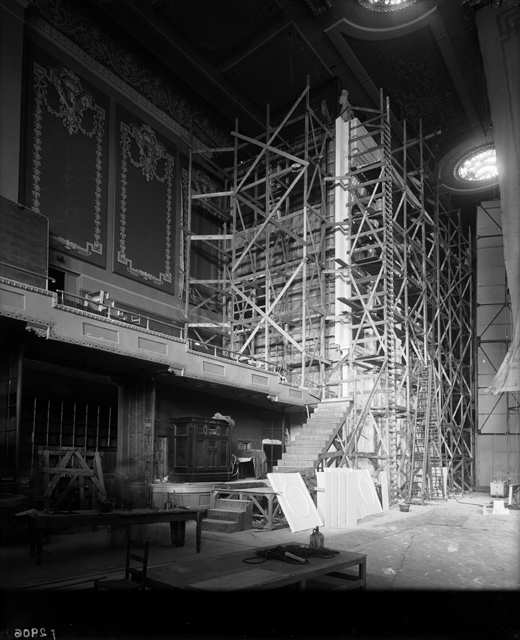
Chambers under construction
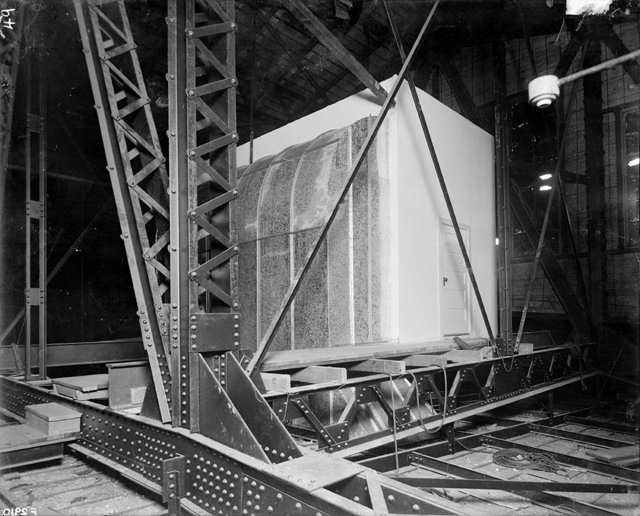
Echo chamber exterior view, with tone chute, directing the sound downwards into the auditorium, prominent
The organ was housed in an impressive enclosure faced with dummy pipes. The console could be raised and lowered in the pit at the front of the stage, and moved around on the stage as required. Photographs show it in several different positions. A photograph of the lift shows a flat platform atop a hydraulic piston. The player unit was housed under the balcony to the left of the main organ case, as was the grand piano, although it would seem the latter was brought out onto the stage as needed. The echo organ was in the auditorium roof and spoke downwards through a tone chute. The 32ft pipes were also located speaking into the roof area.
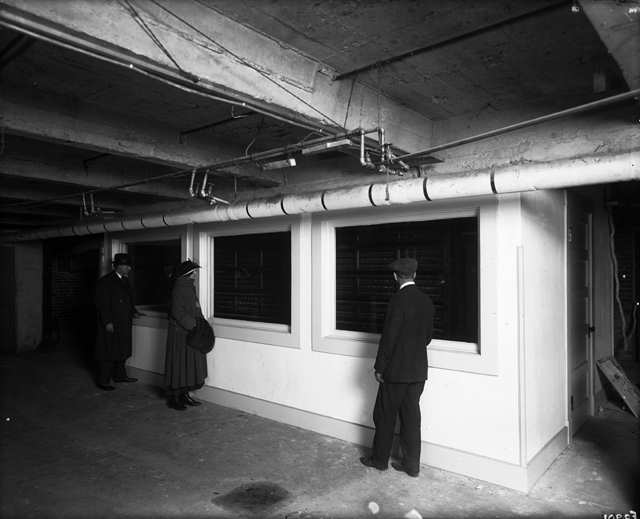
The relay room had windows!
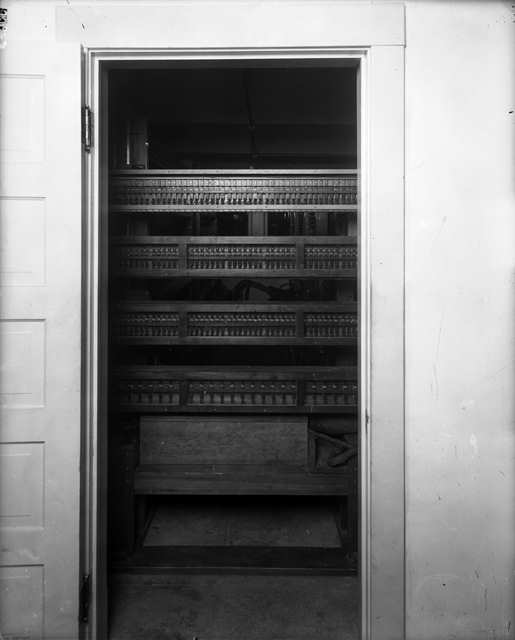
Pizzicato relay
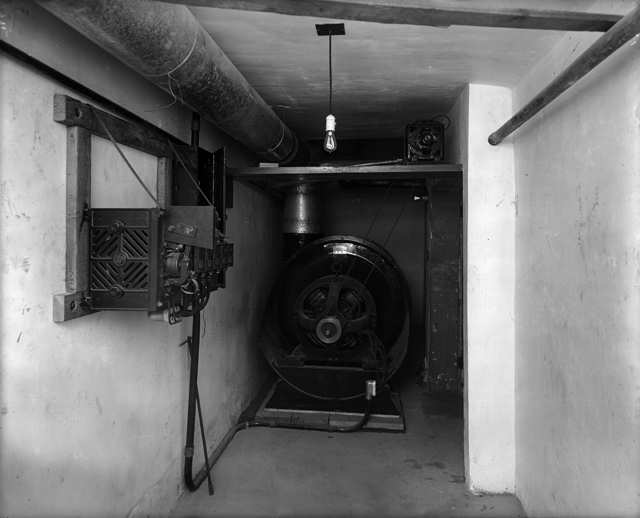
Main blower
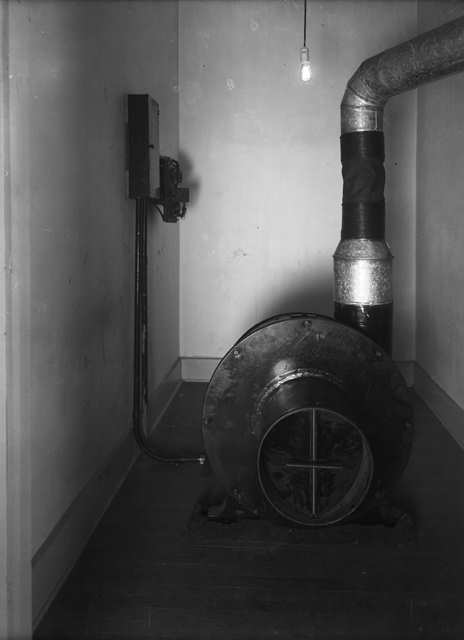
Echo organ blower
There were the usual uninformed stories about the organ never being able to be played full out lest it damage the fabric of the building, but the City Mayor of the time, WFR Mills, wrote to Wurlitzer a testimonial on 3 April, 1919, that included the following:
“… Recently, as you know, Mr Bonnet, the noted French Organist, gave a concert in the Auditorium, which was an artistic success, and from the comments made by musical people, as well as those who enjoy music but do not understand it from a theoretical standpoint, the Organ you have installed in the Auditorium is one of the finest instruments in the country, and we are very proud that such is the fact.”
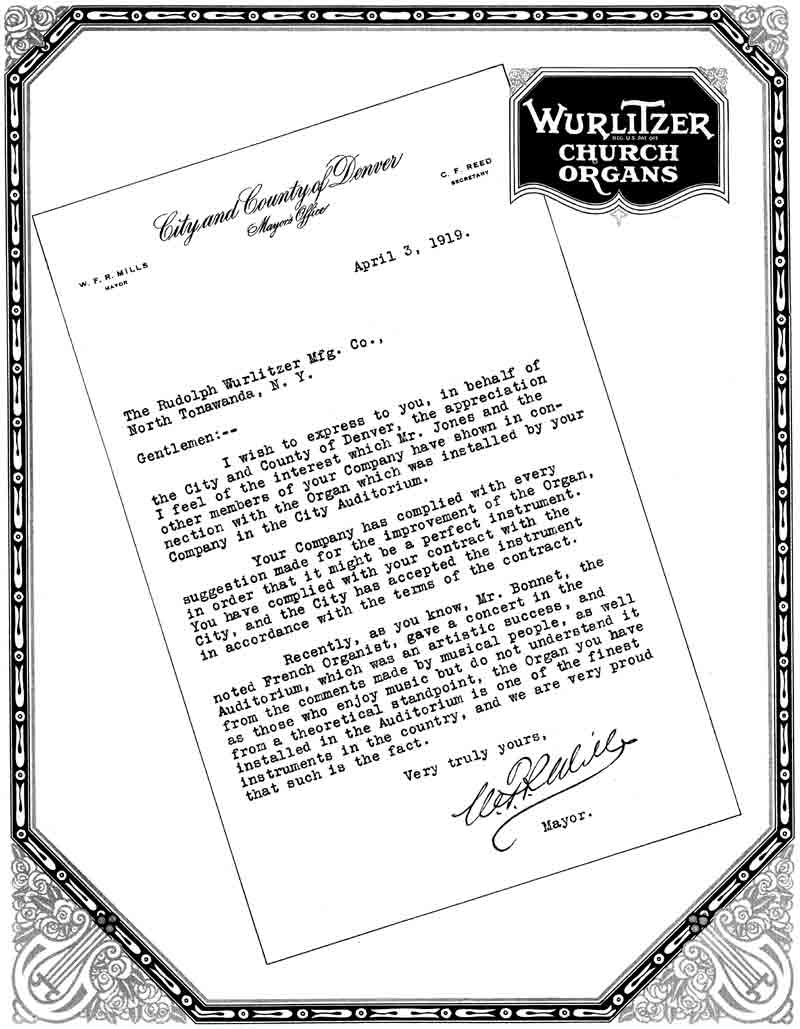
Daily free concerts were provided during the summer months, with “popular priced” concerts by noted artists during the winter season.
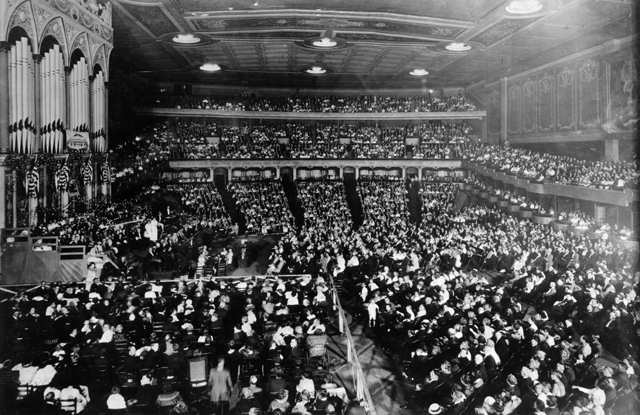
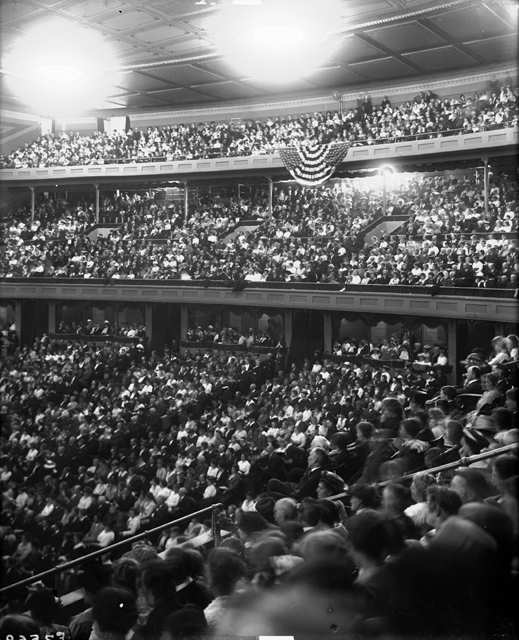
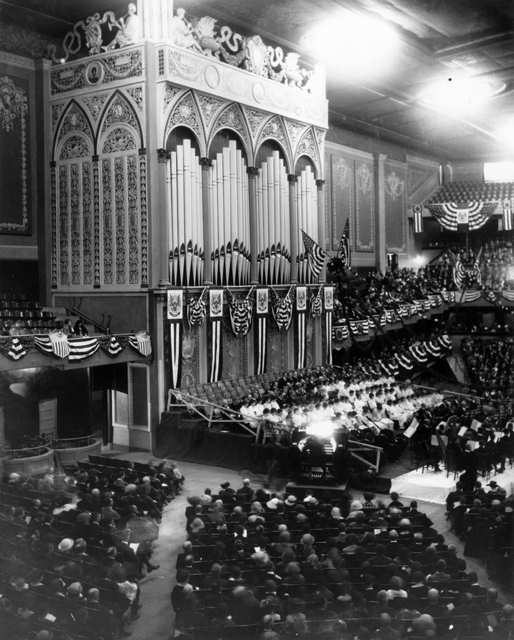
In time, the organ fell out of favour, and when the auditorium was remodelled, there was no longer a place for it. Theatre organ aficionado Dave Bishop tells the tale:
“…When the auditorium was remodelled the city really didn’t know what to do with the organ, since there weren’t any other facilities of that size that needed one and it would have slowed down the schedule to let it go out to bid. So it was kind of finders keepers as to how the pipework was disposed of. Some of it even got turned into cabinets, because there was no market for 32ft diaphones in the home, and pizza parlours with organs were still a few years off.”
He continued by recounting how a friend admired some kitchen cabinets in a house, only to discover they were constructed form timber salvaged from the former municipal organ.
Much of the relays, console and pipework did survive, finding its way into other organs, including most of the rare items: multi-rank strings, Gambas, 16ft Oboe Horn, Trumpet, Kinura, Doppel Flute, Quintadenas, Dolce Diapason, Unda Maris and the 4-rank Vox Humana set.
The Denver console is now at the Nethercutt Collection, San Sylmar, California, having been rebuilt by Ken Crome.
This article compiled using
information from Larry Chace, Dave Junchen/Preston Kauffman “Encyclopaedia of
the American Theatre Organ Vol. 3”, e-mail posting by Dave Bishop and “Wurlitzer
Church Organs” (1924). Photos are from the Colorado State Archive.